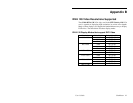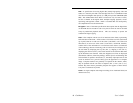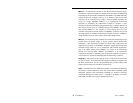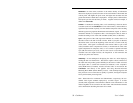
User’s Guide CineMaster 47
Interlace –
The process of repeatedly displaying (scanning) all the lines in an
odd field followed by displaying all the lines in an even field. Interlacing
became part of video technology because early video equipment and televisions
could not operate at high enough frequencies to scan every line on the display
fast enough to produce a good quality image. It became so common that it has
been adopted as a standard part of the video industry. See also: Field, Frame,
De-interlace.
Luminance –
The portion of the video signal that contains information on the
relative brightness content of the image. The luminance channel of any video
signal is the primary waveform encoded on the carrier signal. Traditional black-
and-white televisions uses only a luminance channel (as a variable phase
subcarrier). In S-video, the luminance signal (Y) is maintained as a separate
channel.
Macrovision –
A method for copy-protecting analog video outputs, developed
by Macrovision Corporation. The DVD specification requires that this anti-
taping mechanism be implemented on the S-video and Composite video
outputs to prevent piracy or videotaping of copyrighted material. The copy
protection operates by modifying the sync signal in such a way that VCRs are
adversely affected (causing them to record an unwatchable image) but that
display monitors and televisions are not.
MCI –
A Microsoft standard method for applications to use for accessing
multimedia functions (such as video or audio playback, volume control, etc.).
MCI Commands are fully supported in the
CineMaster
driver, allowing
applications developers to take advantage of the board’s capabilities without
needing to write device drivers or other hardware-dependent code.
MPEG –
The Moving Picture Experts Group. MPEG is a working group of
ISO/IEC in charge of the development of international standards for
compression, decompression, processing, and representation of moving
pictures, audio and their combination.


















